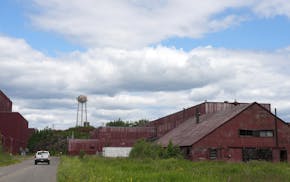Opinion editor's note: Strib Voices publishes a mix of commentary online and in print each day. To contribute, click here.
•••
When the power goes out in Becker County, tiny Pine Point, Minn., is usually the last place to see electricity restored. Located in the isolated southeast corner of the White Earth Nation, this unorganized Ojibwe village of about 350 people boasts a school, a community center, a gas station and not much else.
"There's no employment opportunities; no anything," said Gwe Gasco, an Ojibwe Odawa man with ancestry at White Earth and the Little Traverse Bay Bands in Michigan. "People go 30-40 miles to find work."
But this small community teaches an important lesson about power — the kind in our wires, and the kind that struggling communities can marshal during trying times.
Gasco is the program director for 8th Fire Solar in nearby Osage, a native-owned solar thermal energy company that manufactures and installs solar panels. About five years ago, they started working on a solar-powered backup at the Pine Point School. They call it a "Resilience Hub."
"We're a resilient group of people who've been left alone in the winter for as long as I can remember," said Gasco. "The real idea is that a community should be strong in itself."
The White Earth band sought help from the benefit corporation 10Power to line up funding and coordinate plans for the $4.9 million Resilience Hub project slated to be installed this spring. Sandra Kwak, founder and CEO of 10Power, said more than 14% of people in the White Earth Nation still live without electricity access at home.
Pine Point's hub is one of several renewable energy and industrial projects across the state that emphasize independence over environmental buzzwords. Even as federal policy veers away from the green economy, that economy persists.
"Heat is less about comfort and more about survival," said Gasco. "Projects like this are great from the perspective of tribal communities, but also rural communities as a whole."
Pine Point isn't the only rural community that will benefit from the Resilience Hub. The solar panels will be constructed 162 miles away in the Mesabi Range town of Mountain Iron.
"Money is invested where it brings the best return," said Martin Pochtaruk, CEO of Heliene. This Canadian solar manufacturing firm recently expanded its solar module factory in Mountain Iron and is currently building a second American plant in Rogers, Minn. Heliene builds the solar panels that will power Pine Point's Resilience Hub.
Thanks to better batteries and cheaper panels, solar energy is now the lowest-cost energy source in the world. Energy storage technology continues to improve, and consumer costs are dropping.
For example, said Pochtaruk, a solar panel made by Heliene 14 years ago generated 270 watts. The same sized panel today produces 580 watts at a lower cost.
"The technology has changed materially so that cost is what makes solar the technology of choice," said Pochtaruk. "That is not changing because of a change in the administration of one country."
This trend is creating jobs in rural Minnesota.
Heliene employs about 350 people at Mountain Iron and expects to hire another 150 at the new Rogers plant. These are living-wage jobs, most between $20-$25 an hour.
Even though these solar projects forge ahead, some are slowing. Heliene put a larger Twin Cities-based solar project on hold pending the status of the Inflation Reduction Act, especially its American-made solar incentives.
A solar project here, a small factory there — but what about big industry? You know, the kind of good-paying jobs that power the economy?
Iron ore miners in Minnesota make an average of $90,000 a year, with overtime driving some wages much higher. For a region like the Iron Range, it's hard to focus on economic diversification when such jobs exist.
But there's plenty of reason to anticipate change, highlighted by more than 600 recent layoffs announced two weeks ago. Automation and corporate consolidation winnowed 12,000 mining jobs down to 4,000 over the past 40 years. Minnesota mines make taconite, a low-grade iron ore product that feeds blast furnaces. Blast furnaces are going out of style. All new steel mills use different technology, mostly electric-arc furnaces fed with pure iron or scrap steel.
Coupled with that change is the rise of new "green steel" technology that reduces the use of carbon in one of the world's most polluting industries.
About 10% of carbon emissions in the world comes from steel production. This new tech uses hydrogen to reduce the need for coal in the steelmaking process. When fed with electricity from renewables or non-carbon sources, "green steel" might become carbon neutral and cost effective. It's already becoming the industry standard across the globe.
"If we don't have an answer on green steel, we won't be competitive," said Rolf Weberg, director of the Natural Resources Research Institute at the University of Minnesota Duluth.
This year, NRRI received a $1.3 million grant from the U.S. Department of Energy to explore the feasibility of green steel in northern Minnesota. Ultimately, the study will spend more than $5 million from state and private sources and take about year to complete.
The scope of the study, the first of its kind backed by the Midwest Industrial Transformation Initiative, is stunning. It's not only exploring green steel but all the ways that corresponding industries might sync new technology. Cement production, hydrogen production and storage, renewable energy, fertilizer and e-fuels could connect in a matrix of interconnected projects.
"The industry has made a lot of changes, but we still make taconite and we have to make higher-value products," said Weberg. "If we don't invest now, the future of iron will come from Brazil and eastern Canada."
Thus, green technology is not only key to new jobs, it could save whole industries in Minnesota from obsolescence.
To be independent, we must understand how we are interdependent. Residents of a small community keeping warm during power outages can scale up to technology that cleans up one of the world's most polluting industries. In times defined by fear and contempt, this brings hope.

Brown: Trump boosts NorthMet, but mines need strong economy, not just bluster

Brown: U.S. Hockey Hall of Fame debate crashes into the boards

Brown: Lessons on courage from the plucky mama duck in the DNR's EagleCam nest

